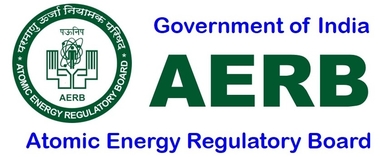About AERB
The Atomic Energy Regulatory Board was constituted on November 15, 1983, by the President of India by exercising the powers conferred by the Atomic Energy Act, 1962 to carry out certain regulatory and safety functions under the Act. The regulatory authority of AERB is derived from the rules and notifications promulgated under the Atomic Energy Act and the Environment (Protection) Act, 1986.
The Mission of the AERB is to ensure the use of ionizing radiation and nuclear energy in India does not cause undue risk to the health of people and the environment.
The Atomic Energy Regulatory Board (AERB) has the mandate to enforce rules and regulations promulgated under the Atomic Energy Act, 1962 for ensuring radiological safety in the country. AERB also administers the provisions of Factories Act, 1948 for ensuring industrial safety in the units of the Department of Atomic Energy that are under the purview of the Board.
Currently, the Board consists of a full-time Chairman, an ex-officio Member, four part-time Members and a Secretary.
AERB has a Chairman, an Executive Director and Directors/Heads of various Divisions/Directorates. The Directors/Heads of Divisions/Directorates constitute the Executive Committee which meets periodically with Executive Director, AERB to take decisions on important policy matters related to the management of the Secretariat of the Board.
In addition, a Safety Research Institute was set up at Kalpakkam to carry out and promote safety related research in areas of relevance to regulatory functions.
AERB has a mechanism to check its effectiveness and quality assurance in its activities and a process by which it improves its systems through its own experience feedback and international regulatory practices.
Committees
AERB is supported in its functions by a number of committees. Members of all the AERB committees are recognized experts with long experience in the relevant fields and come from DAE units, various Governmental organizations, academic institutes and industry. A large number of retired experts are also members of the various AERB Committees.
The apex safety review committees of AERB are the Safety Review Committee for Operating Plants (SARCOP) and the Safety Review Committee for Applications of Radiation (SARCAR). SARCOP was constituted in June, 1988 to evaluate and enforce nuclear, radiological and industrial safety in all operating units including public sector undertakings of the Department of Atomic Energy, for ensuring safety of the operating personnel, members of the public and the environment. SARCOP is supported by a number of specialist committees. In addition, there is a unit safety committee for each operating unit (or a group of units) for detailed operational safety review of individual units and advising SARCOP. In 1987, AERB constituted a Committee known as Licensing and Appellate Committee. This committee was restructured in 1991 with a new name as Safety Review Committee for Applications of Radiation (SARCAR) with a view to streamlining the implementation of Radiation Protection Rules in all practices and organizations using radioisotopes and radiation sources in medical, industrial and research institutes.
The formation of AERB: Down the memory lane
During the commissioning of Tarapur Atomic Power Station (TAPS 1&2) in 1969, the Department of Atomic Energy (DAE) set up a safety committee to receive advice on matters related to safety and to give clearance for first criticality and subsequent power operation of the station. A Design and Operations Review Committee was later constituted to monitor the safety aspects of TAPS 1&2 operation independently.
DAE Safety Review Committee (DAE-SRC)
Recommendation to set up AERB
On July 23, 1979 Secretary, DAE constituted a Committee chaired by Dr. M.D. Karkhanawala, Chairman, DAE-SRC with Shri S.D. Soman the then Head, Health Physics Division as Member-Secretary to study "the existing terms of reference of SRC, its functions, the modalities of reporting by the Units as well as the impediments faced by the Committee". According to the notification of setting up the committee, the review of the terms of reference and the working of the Safety Review Committee became necessary "to ensure that not only safety consciousness is inculcated, but that safe practices prevail in all the Units of the DAE including the public sector undertakings".
The Committee was asked to report on the specific functions and responsibilities of SRC in order to enable the DAE to discharge its obligations under the Atomic Energy Act in so far as all the units as well as the public sector undertakings of the Department are concerned.
The Committee was reconstituted on February 18, 1980 with Shri V.N. Meckoni, the then Director, Chemical Group, BARC as the Chairman and Shri S.D. Soman, the then Head, Health Physics Division as Member-Secretary. The Report of the Committee titled "Reorganization of Regulatory and Safety Functions" (February 1981) recommended "the creation of Atomic Energy Regulatory Board by the Atomic Energy Commission with powers to lay down safety standards and assist DAE in framing rules and regulations for enforcing regulatory and safety requirements envisaged under the Atomic Energy Act, 1962". The Committee also recommended that AERB "should be a statutory body under the Act (if necessary by suitable amendment of the Act) to give AERB a legal basis".
The Committee stated that "in order to enable AERB to function effectively and exercise its authority in an independent manner it should be constituted by and reporting to the Atomic Energy Commission and should consist of senior persons from DAE as well as external members. In this manner public confidence in nuclear safety matter would be enhanced".
The current functions and powers of AERB are almost verbatim taken from the report of the committee. AERB was set up on November 15, 1983. A separate notification indicating the functions and responsibilities of DAE-SRC was issued simultaneously. AERB's functions included enforcement of provisions of radiological protection in the radiation installations outside the DAE. Professor A.K.De, formerly Director, Indian Institute of Technology, Bombay, was appointed the first Chairman of AERB.
A Committee set up on March 21, 1987 with Shri V.N. Meckoni as Chairman reviewed the functions and responsibilities of AERB. The Committee submitted its recommendations on May 15, 1987. These were accepted by the Government. As recommended by the Committee, DAE-SRC became a part of AERB as AERB-SRC and later as Safety Review Committee for Operating Plants (AERB-SARCOP). The functions and responsibilities of AERB were broadened considerably. Currently, AERB is carrying out its functions as per the original notification and in the light of the recommendations of the Meckoni Committee.







